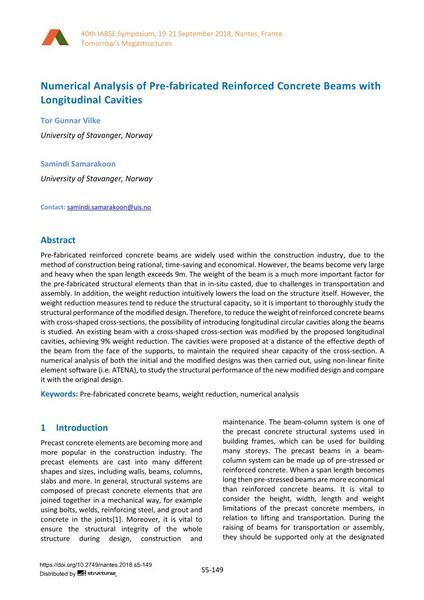Numerical Analysis of Pre-fabricated Reinforced Concrete Beams with Longitudinal Cavities

|
|
|||||||||||
Bibliografische Angaben
| Autor(en): |
Tor Gunnar Vilke
(University of Stavanger, Norway)
Samindi Samarakoon (University of Stavanger, Norway) |
||||
|---|---|---|---|---|---|
| Medium: | Tagungsbeitrag | ||||
| Sprache(n): | Englisch | ||||
| Tagung: | IABSE Symposium: Tomorrow’s Megastructures, Nantes, France, 19-21 September 2018 | ||||
| Veröffentlicht in: | IABSE Symposium Nantes 2018 | ||||
|
|||||
| Seite(n): | S5-149 | ||||
| Anzahl der Seiten (im PDF): | 8 | ||||
| DOI: | 10.2749/nantes.2018.s5-149 | ||||
| Abstrakt: |
Pre-fabricated reinforced concrete beams are widely used within the construction industry, due to the method of construction being rational, time-saving and economical. However, the beams become very large and heavy when the span length exceeds 9m. The weight of the beam is a much more important factor for the pre-fabricated structural elements than that in in-situ casted, due to challenges in transportation and assembly. In addition, the weight reduction intuitively lowers the load on the structure itself. However, the weight reduction measures tend to reduce the structural capacity, so it is important to thoroughly study the structural performance of the modified design. Therefore, to reduce the weight of reinforced concrete beams with cross-shaped cross-sections, the possibility of introducing longitudinal circular cavities along the beams is studied. An existing beam with a cross-shaped cross-section was modified by the proposed longitudinal cavities, achieving 9% weight reduction. The cavities were proposed at a distance of the effective depth of the beam from the face of the supports, to maintain the required shear capacity of the cross-section. A numerical analysis of both the initial and the modified designs was then carried out, using non-linear finite element software (i.e. ATENA), to study the structural performance of the new modified design and compare it with the original design. |
||||
| Stichwörter: |
numerische Analyse
|
||||
